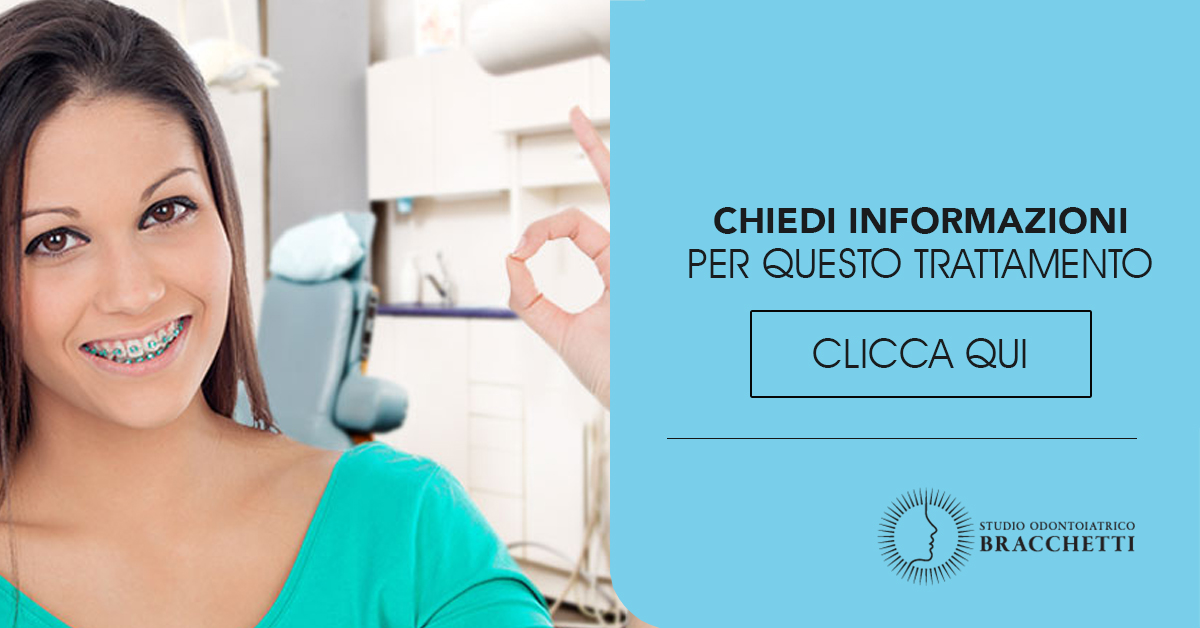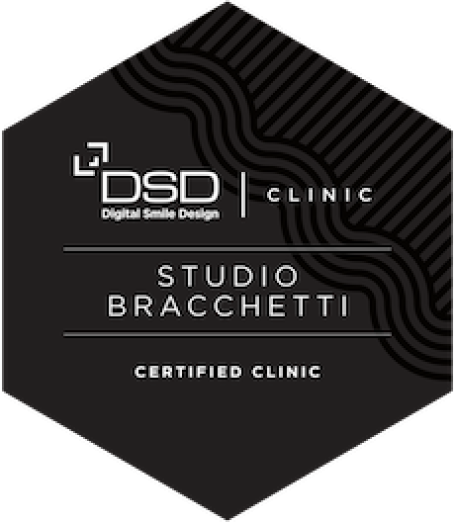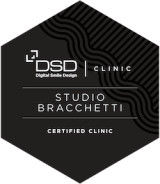Questions and Answers on orthodontics
At the Bracchetti Dental Clinic in Milan we are experts in orthodontics for children and adults. We are here to answer any questions regarding your smile alignment, whether orthodontics is the right choice for you and which orthodontic system might work best for you.
If you are considering a dental alignment treatment and have any questions, you can book an appointment with our orthodontist.
We've answered some of the most frequently asked questions below.
How long can an orthodontic treatment for adults last?
On average an orthodontic treatment for adults can last from 9 to 15 months. This active treatment period will always be followed by a restraint phase to maintain the result achieved.
Which system should I choose for the alignment treatment of my teeth or my child's teeth?
During the consultation, your dentist will explain the different solutions in terms of orthodontic appliances and will recommend the best treatment option based on your current smile, lifestyle and budget.
Fixed braces mean less effort for the patient - the dentist will do most of the necessary work during the office appointments. Your job is mainly to keep your teeth clean and to show up regularly for scheduled appointments.
Invisalign removable aligners have the drawback of having to be removed every time you eat or drink, but they also have the advantage of being less visible to others.
In terms of cost and efficiency, all the tooth straightening systems we offer are similar.
What are the risks if you wait too long to intervene orthodontically?
The problem is that, if there are problems related to development, or we intervene during growth to obtain orthopedic results, redirecting, containing or stimulating the growth of the jaws, or the treatment after adolescence is reduced to movements purely dental. In this sense, the orthodontic treatment done after the age of 14-15 is neither more nor less comparable in terms of potential and results to that done to an adult, with the growth completed. There is therefore a risk of having to make more drastic therapeutic choices.
How do I know if my child has an open bite or a cross bite and what does it mean for their teeth and mouth?
An open bite occurs when the upper and lower front teeth do not close frontally and there is a vertical gap between them.
Crossbite is about the posterior teeth. The upper arch should be wider than the lower arch and therefore contain it. If for some reason the upper arch falls into the lower arch on one side or both sides, this condition is called posterior crossbite.
An anterior crossbite occurs when the lower arch protrudes anteriorly with respect to the upper. This is found more often in children and is one of the few cases in which intervention is made on children as young as five to six because, if left untreated, it can lead to an impediment to the correct development of the upper jaw.
Is it easy to talk with fixed braces/ aligners?
Yes, of course, although it depends on each person. Only after the initial positioning of a fixed appliance, it can take a few days to get used to it. For this reason we place the fixed appliances on the first appointment and then, a week later, we apply the threads that activate the dental movement. With Invisalign speech is certainly less influenced.
Can orthodontics correct the space between my front teeth?
For this problem you can use both a traditional fixed appliance and the removable transparent aligners. The orthodontic brackets should be placed on some teeth straddling the diastema (the space between the anterior teeth) in order to close the space. For the same problem it is possible to use the transparent removable aligners obtaining the same result.
Whichever system you choose, there is the possibility that the teeth have a tendency to regress to their old positions and the space can reopen. To avoid this inconvenience, a longer-lasting restraint is usually recommended. A fixed holding device (splinting) behind the incisors is often used for this purpose to keep the teeth in position long term.
How do people feel about their straighter teeth?
Patients often speak of a new confidence in their smile. It is not uncommon for patients to ask for whitening treatment after straightening their teeth, to fully enjoy their new smile.
What should I expect after having the orthodontic treatment for me or my child?
Once your teeth have moved to their new, more aligned and correct position, there is a final check during which we will plan the removal of the braces. The same thing if the treatment concerns the child.
In particular, a restraint device will be created for each arch that has been subjected to orthodontic treatment. You will have to wear this maintainer for a few months, to varying degrees depending on the type of movement performed on the teeth. Use will gradually decrease from 24 hours a day to use only at night and then on alternate nights. To monitor the stability of the orthodontic treatment, you will be called back for regular maintenance appointments, even if more and more spaced apart.
It is very important to follow the instructions given in the maintenance period to allow the teeth to remain in their new position for a long time.
What is the best toothbrush to use with the appliance?
Wearing orthodontic braces makes cleaning your teeth more complicated as plaque builds up quickly around brackets, ligatures, and floss. Daily oral hygiene with the correct toothbrush is essential to prevent tooth decay, inflammation of the gums, and bad breath.
There are orthodontic toothbrushes on the market, easily purchased in the best-stocked pharmacies and supermarkets. They are equipped with soft bristles and have a small head with the bristles to scale towards the center, more suitable for reaching both orthodontic equipment and, at the same time, the tooth surface and the gums in the neck area, i.e. at the junction between tooth and gum.
This is the area to pay the most attention to, using simple but effective techniques that allow for optimal hygiene even during orthodontic therapy with fixed equipment.
How can orthodontics improve the health of the entire mouth?
Orthodontics means much more than the aesthetic advantage of having a more beautiful smile. It can have a great impact on the oral and dental health of the individual.
In fact, it is possible to keep teeth cleaner by promoting long-term periodontal health of the bone and gums and preventing the onset of caries.
If the teeth, on the other hand, do not close properly with the teeth of the opposite arch, it is possible that wear on the dental surfaces is created, which is irreversible. If, on the other hand, you straighten your teeth with an orthodontic appliance, you get an advantage: you can reduce the likelihood of occlusal trauma occurring which over time could lead to wear of the dental surfaces and bone resorption and gum recession.
Can orthodontics improve gum health?
If you have crowding problems, oral hygiene can be more difficult and this can lead to the accumulation of plaque and inflammation of the gums.
Occlusal trauma due to dental malposition can cause damage to the mouth, involving the bone and gums which could be reabsorbed over time. For this reason, orthodontic alignment and bite correction in many cases favor gum health and oral health in general.
Do fixed / aligners correct temporomandibular joint (TMJ) problems and bruxism?
Before we know if orthodontics can help solve a TMJ problem, we should diagnose the cause of the jaw pain. Pain in the temporomandibular joint could be caused by several factors, but in those cases where the problem is attributable to the way the teeth close, then appliances and aligners can help.
What should patients do to maintain oral hygiene during orthodontic treatment?
We give all patients an oral hygiene kit at the beginning of treatment. This provides our patients with the appropriate tools to better manage their oral health during treatment. In fact, at each appointment we also check hygiene and the presence of dental problems. If problems are highlighted, we suggest seeing the hygienist or general dentist during orthodontic treatment.
Can I use the toothbrush with the fixed appliance?
Absolutely yes! During treatment with a fixed appliance, the risk of caries may be higher if more plaque build-up is allowed than usual, and also increases the difficulty in removing it. There is a special toothbrush for this: the orthodontic toothbrush.
It is used in the presence of fixed equipment to eliminate the accumulation of plaque around the attachments. It differs from the traditional one for the "V" profile due to the presence of higher rows of external bristles than the internal ones to better wrap around the orthodontic attachments.
If the appliance breaks down, what happens?
You need to call the office immediately. Depending on the type of damage an emergency appointment will be set or instructions on what to do. If the damage has occurred to a removable appliance, it can often be repaired and a new impression will need to be taken. In the case of fixed equipment, the bracket that has detached or replaced the damaged arch or band will be reattached. In any case, by contacting the office, instructions will be promptly given on how to manage the emergency and reduce or cancel any nuisance. / p>
How much does an orthodontic appliance cost?
It depends! Removable functional appliances can have a variable cost between € 1500 and € 3000, treatments with fixed equipment have a variable cost depending on the complexity of the case, the duration of the treatment, and the equipment used (traditional, aesthetic). Indicatively between € 3500 and € 6500. Invisalign between € 4000 and € 6500/7000.
If you would like to make an appointment at the Bracchetti Dental Clinic in Milan click Request form - Or you can write us on whatsapp and if you want to talk to the secretary you can do so easily by calling the office by clicking here
















